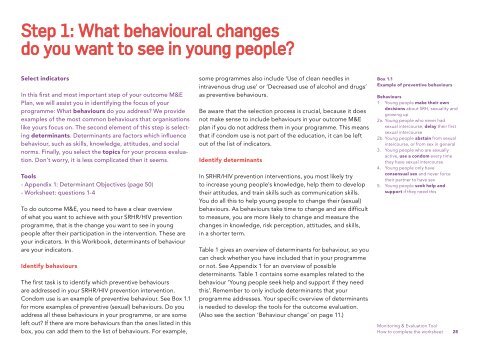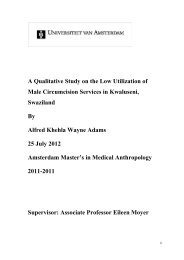ARE YOU ON THE RIGHT TRACK? - Rutgers WPF
ARE YOU ON THE RIGHT TRACK? - Rutgers WPF
ARE YOU ON THE RIGHT TRACK? - Rutgers WPF
- No tags were found...
You also want an ePaper? Increase the reach of your titles
YUMPU automatically turns print PDFs into web optimized ePapers that Google loves.
Step 1: What behavioural changesdo you want to see in young people?Select indicatorsIn this first and most important step of your outcome M&EPlan, we will assist you in identifying the focus of yourprogramme: What behaviours do you address? We provideexamples of the most common behaviours that organisationslike yours focus on. The second element of this step is selectingdeterminants. Determinants are factors which influencebehaviour, such as skills, knowledge, attitudes, and socialnorms. Finally, you select the topics for your process evaluation.Don’t worry, it is less complicated then it seems.Tools- Appendix 1: Determinant Objectives (page 50)- Worksheet: questions 1-4To do outcome M&E, you need to have a clear overviewof what you want to achieve with your SRHR/HIV preventionprogramme, that is the change you want to see in youngpeople after their participation in the intervention. These areyour indicators. In this Workbook, determinants of behaviourare your indicators.Identify behavioursThe first task is to identify which preventive behavioursare addressed in your SRHR/HIV prevention intervention.Condom use is an example of preventive behaviour. See Box 1.1for more examples of preventive (sexual) behaviours. Do youaddress all these behaviours in your programme, or are someleft out? If there are more behaviours than the ones listed in thisbox, you can add them to the list of behaviours. For example,some programmes also include ‘Use of clean needles inintravenous drug use’ or ‘Decreased use of alcohol and drugs’as preventive behaviours.Be aware that the selection process is crucial, because it doesnot make sense to include behaviours in your outcome M&Eplan if you do not address them in your programme. This meansthat if condom use is not part of the education, it can be leftout of the list of indicators.Identify determinantsIn SRHR/HIV prevention interventions, you most likely tryto increase young people’s knowledge, help them to developtheir attitudes, and train skills such as communication skills.You do all this to help young people to change their (sexual)behaviours. As behaviours take time to change and are difficultto measure, you are more likely to change and measure thechanges in knowledge, risk perception, attitudes, and skills,in a shorter term.Table 1 gives an overview of determinants for behaviour, so youcan check whether you have included that in your programmeor not. See Appendix 1 for an overview of possibledeterminants. Table 1 contains some examples related to thebehaviour ‘Young people seek help and support if they needthis’. Remember to only include determinants that yourprogramme addresses. Your specific overview of determinantsis needed to develop the tools for the outcome evaluation.(Also see the section ‘Behaviour change’ on page 11.)Box 1.1Example of preventive behavioursBehaviours1. Young people make their owndecisions about SRH, sexuality andgrowing up2a. Young people who never hadsexual intercourse, delay their firstsexual intercourse2b. Young people abstain from sexualintercourse, or from sex in general3. Young people who are sexuallyactive, use a condom every timethey have sexual intercourse4. Young people only haveconsensual sex and never forcetheir partner to have sex5. Young people seek help andsupport if they need thisMonitoring & Evaluation ToolHow to complete the worksheet 28





